
Mexico City’s office and lodging markets have gradually evolved over the last decade. Investment in the country has resulted in the arrival of new companies and the expansion of many already in operation. This in turn has given rise to a growing Class A office market and increased demand for hotel accommodations. This article examines the relationship between foreign direct investment, demand for office space, and lodging demand in Mexico City—one of the largest and most dynamic metropolitan centers in the world.
Foreign Direct Investment – A Key Economic Driver
On the world stage, many economic, political, and social developments in Mexico have been overshadowed by recent media attention focused on the government’s efforts to eliminate drug-trafficking violence in border regions of the country. Yet in the past 16 years, Mexico’s political system has transitioned from one dominated since 1921 by one-party rule to an active multi-party democracy. Material changes to Mexico’s economy include the unilateral lowering of trade barriers and entrance into GATT (now the World Trade Organization) in 1986, the 1994 signing of the North American Free Trade Agreement (NAFTA), and the nation’s subsequent entrance into a similar free-trade accord with the European Union.
As shown in Figure 1, annual foreign direct investment in Mexico has grown dramatically since 1995, creating a backbone of industrial activity and supporting a trend toward job growth. These developments were accompanied by other structural economic changes, including privatization of certain industries previously controlled by the government, as well as improvements in road and airport infrastructure.
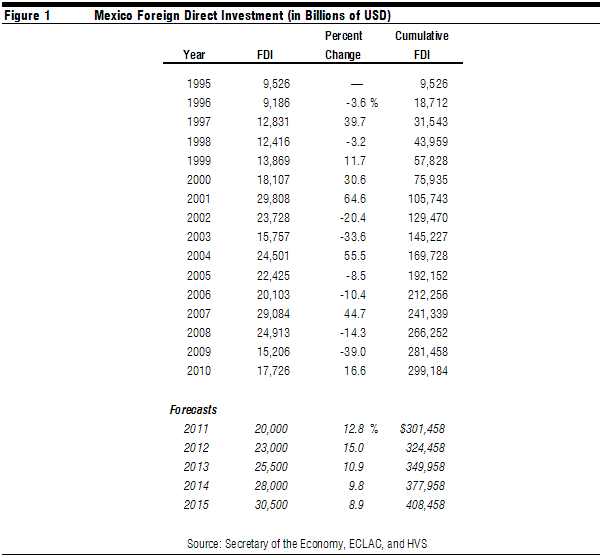
Foreign direct investment decreased in Mexico in 2009, as was the case in nearly every Latin American country. Mexico’s economy fluctuates with that of the United States and was particularly hard-hit during the recent economic downturn. The loss of business and tourism in the months following the H1N1 outbreak in April of 2009 made things worse. However, according to Mexico’s Secretary of the Economy, Foreign Direct Investment rose to $17.726 billion USD in 2010, representing a 16.6% increase from 2009. The same source reported that in 2010 the most attractive segments for foreign direct investment were manufacturing (59.7%), commerce (14.2%), financial services (13.8%), other services (7.6%), and other sectors (4.7%).1
This optimism is supported by Mexico’s leap in ranking on A.T. Kearney’s 2010 FDI Confidence Index. Despite declining oil production, media focus on drug-trafficking crime in limited areas of the country, and the worst recession since the 1930s, Mexico remains a popular location for light industry and U.S.-based companies looking to reduce costs. The manufacturing sector, overall employment, and commercial, retail, and tourism projects in the country have continued to grow during the past decade.
According to a report published by the Economic Commission for Latin America and the Caribbean in 2010, Mexico’s manufacturing and services sectors continue to receive the most foreign direct investment, at 49% and 42%, respectively. The manufacturing sector includes the production of metal products, machinery, and equipment and is closely tied to the U.S. economy, particularly the automotive industry. The services sector includes the financial, trade, healthcare, and hospitality industries, among others.
The impact of rising foreign direct investment has made its mark on the real estate sector as well. Industrial parks mirroring those across the U.S. border have been developed throughout northern and central Mexico, financed by both domestic and international investment funds and banks. Class A office buildings developed to international standards have multiplied, primarily in Mexico City, which remains the key financial and corporate center of the country. Both industrial and office assets are part of sophisticated real estate capital markets, with mid- to long-term lease periods, often in U.S. dollars, also financed by both domestic and international investment funds and banks. Department-store-anchored regional shopping centers and grocery-anchored neighborhood centers have also increased in number to serve a growing middle class, which is gradually transitioning from employment in rural and informal sectors to NAFTA-related jobs in key economic corridors. Private developers and dedicated government agencies have designed and implemented mechanisms allowing massive development of affordable and middle-income housing product, with the annual inventory also growing significantly over the last decade, providing start-up housing for young couples and families.
The rise in investment and economic activity has brought increased demand for business and leisure travel. Leisure travel continues to proliferate for many coastal and interior destinations within Mexico, which hosted over 22 million international visitors in 2010.1 This has given rise to the development of full-service, limited-service, and economy hotels throughout the country, with more set to follow in the coming years.
Tracking Office Space in Mexico City
Foreign direct investment, coupled with population growth and the broadening of the service sector, has resulted in a growing office market in Mexico City. Total available Class A office space increased from 672,273 square meters in 1995 to 3,087,197 square meters in 2009. This translates into an average annual compounded increase of 11.5%, or 172,423 square meters of additional office space each year.
Figure 2 below illustrates the amount of available and absorbed Class A office space from 1995 through the third quarter of 2010.
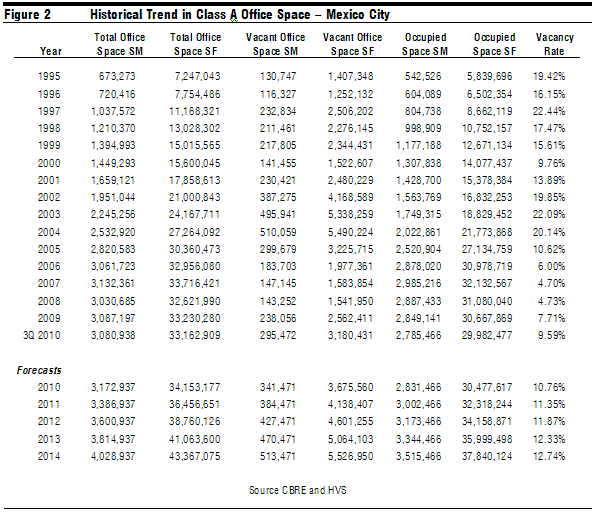
In the period from 2006 through the third quarter of 2010, vacancy rates remained below 10%. Vacancy rates are forecast to move slightly upward through 2014 as supply increases, which have been minimal over the past few years, continue to ramp up.
Over the past 20 years, office development in Mexico City has taken place along two key axes. The first, known as the Reforma to Santa Fé corridor, extends due west along Paseo de la Reforma from the old city center (Centro Histórico) through several office submarkets referred to as Reforma, Polanco, Lomas, Bosques de las Lomas, and Santa Fé. This corridor houses the majority of national and international corporate headquarters in the city, as well as most of its branded, full-service hotels. The second axis, which extends south from Centro Histórico, includes the Insurgentes and Perisur submarkets. Office hubs and a diverse, albeit smaller, supply of hotel assets are spread along this axis.
As of the third quarter of 2010, the Reforma to Santa Fé corridor housed 2.3 million square meters of Class A office space, equivalent to 76% of all Class A office space in Mexico City.
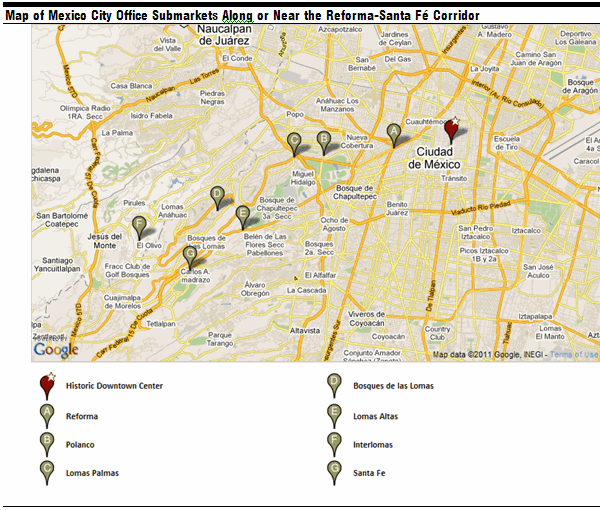
More foreign direct investment in Mexico has corresponded to an increase in office space, led by industrial growth in northern and central Mexico and a growing corporate presence in Mexico City. Approximately 951,000 square meters of office space were under construction in Mexico City as of the third quarter of 2010.2 This represents 30% of the existing supply of the city’s Class A office space.
The following chart illustrates the relationship between foreign direct investment and available office space in Mexico City since 1995, along with forecasts for 2010 through 2014.3
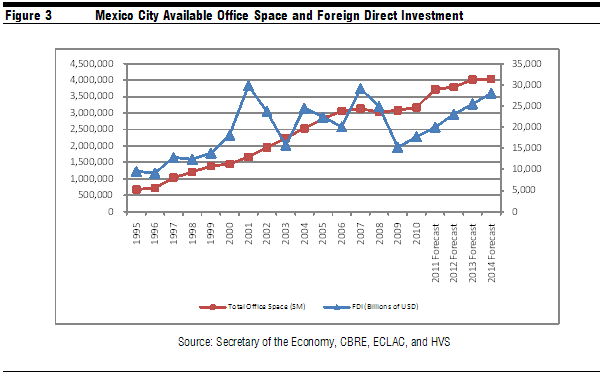
A More Detailed Review of the Reforma Submarket
Government initiatives and incentives to redevelop Paseo de la Reforma (the main roadway along the Reforma to Santa Fé corridor) have kindled interest among private real estate developers. Approximately 48% of the office space under construction in the city (457,000 square meters) will be located along Paseo de la Reforma from the area known as La Alameda Central near the Centro Histórico to the intersection of Paseo de la Reforma with Avenida Mariano Escobedo. Within this same 3.5-kilometer corridor, an additional 231,000 square meters of office space have been proposed.
The amount of Class A office space under construction represents a 192% increase in supply over current 237,321 square meters in the Reforma district. The addition of office space proposed (i.e., not yet under construction) for this district would swell the rise to 290%. Since 1995, Mexico City has absorbed an average of approximately 171,000 square meters of Class A office space annually. The forecasted increase of 951,000 square meters for the entire Mexico City area over the next five years should be largely absorbed as new businesses seek space in the city. Expected increases in supply should keep rental rates relatively stable in this market.
Figure 4 lists major office developments proposed for the Reforma submarket, and Figure 5 maps their locations.
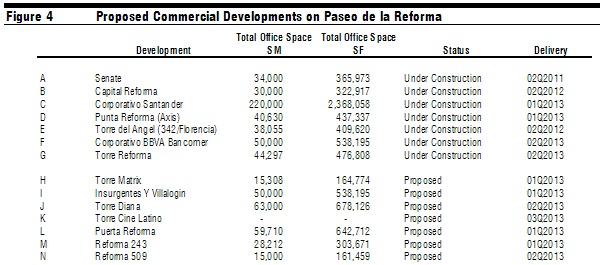
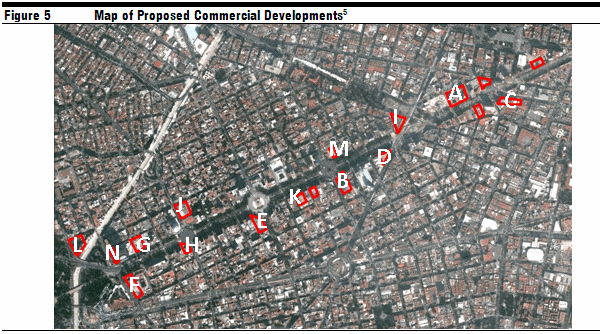
*Map Source: Google Earth
Hotel Supply and Demand
Occupancy for hotels along Mexico City’s Reforma to Santa Fé Corridor has been relatively stable over the past 15 years, with the exception of the drop in 2009 caused by the effects of the recent recession and the H1N1 scare. Moreover, there is a strong correlation between the absorption of new hotel rooms and the increase in foreign direct investment and office inventory.
Lodging demand began to strengthen in September of 2009 and continued to improve into 2010. Lodging data for hotels along the Paseo de la Reforma corridor are presented in Figure 6 below.

These figures represent a very stable hotel market. The table above also illustrates that, since 1994, the corridor has absorbed an average of 48,000 room nights annually. Limited supply is expected throughout the city, which should aid the recovery of existing hotels. New supply anticipated for the Reforma and Santa Fé submarkets includes a 150-room Park Hyatt (currently on hold), a W Hotel (scheduled to open in 2013), and a Marriott Edition (expected to open mid-year 2011).
The Polanco hotel district has long been considered an especially attractive location given its proximity to prime office markets in the Lomas, Polanco, and Reforma submarkets. New hotels have come online in recent years to service demand created by the maturing Bosques de las Lomas and Santa Fé submarkets, which now house many commercial and financial headquarters.
During the 1990s, as hotel corridors spread from the city center toward the western suburbs, the Reforma to Santa Fé corridor seemed stalled. But the area provides a rare opportunity for development in one of the densest parts of Mexico City, where sites zoned for hotel development have become very hard to find. The corridor’s access to extensive public transportation, along with government revitalization efforts, has also encouraged new investments.
Most development in the Reforma to Santa Fé corridor centers on high-end office and residential projects, with few sites dedicated to the construction of hotel assets, whether free-standing or within mixed-use projects. In the mid-term, we expect the corridor’s lodging demand base to expand, allowing for existing hotels to achieve higher occupancy and command higher rates as proposed supply stabilizes. Local and federal tourism authorities continue to promote leisure visitation to Mexico City both nationally and abroad, which has the potential to bolster weekend occupancy in a hotel market historically dominated by weeknights. At the same time, the staggered delivery of new commercial developments over the next five years should further strengthen weekend demand, especially during peak seasons. Average rates should see a gradual rise with the concentration of higher-rated commercial demand.
Wrap-up
The Mexico City office and lodging market is in the midst of a renaissance. As foreign direct investment is forecast to continue to increase in Mexico, broader real estate development in the local market should benefit existing and future hotels in Mexico City. This factor, coupled with limited increases of hotel supply, should result in improving occupancies and average rates for area hotels, perhaps exceeding levels achieved prior to the economic recession of 2008/09.
1 Mexico’s Secretary of the Economy Press Room http://www.economia.gob.mx/swb/en/economia/p_Sala_de_Prensa (February 2011)
2 Datatur
3 CBRE 3rd Quarter 2010 MarketView office market report.
4 Forecasts for FDI were provided by the Mexican Secretary of the Economy for 2010 and reflect an estimated recovery to top historical levels through 2014.
5 Delineations on the map that are not labeled with a letter depict residential developments, which we have not detailed in this report.



Richard and Luigi, this is one of the best articles I've ever come across on Mexico City, It is extremely informative regarding the office market and the increased demand for hotel accommodations, and should be of great interest to foreign investors in the country. Your historical perspective and forecast for the future of this type of investment is enlightening, particularly with the bad press Mexico has received of late which you cover very well. The Hotel Supply and Demand section is excellent. Congratulations on a job well done! It was great seeing you at your inaugural conference which was a great success!
Luigi and Richard - Such an informative article. Excellent use of data and graphics to illustrate your thesis. Well done. I will pass this on to industry contacts. Bethany
Dear Friends I have read with interest your article. Congratulations ¡¡¡ In general terms the vision of the country and information related with the most probable local is very reliable. However, it is necessary, from my personal point of view, to make some specific comments: You still give full effect to a comment by Economy Secretary Gerardo Ruiz Mateos, when he left office on July 15, 2010. With such rapid changes woul match the visions of Gerardo Ruiz Mateos with the view of Bruno Ferrari`s prospective ideas? Why not you use a more recent opinion? I imagine that its publication is not intended to be so academic, but a more specific reference to sources of information would be of great benefit to your readers. "According to a published report" , sounds like "Once upon a time". Best regards Luis Ignacio Hernandez Vivar Especialista en Valuación Inmobiliaria, Actuario y Matematico Ciudad de Mexico
Mr. Hernandez, thank you very much for your thoughtful comment. The quote/comment on FDI forecast by Secretary Gerardo Ruiz was included due to lack of official 2010 FDI totals at the time of publishing. Now that these amounts have recently been published, we have updated the article and provided the applicable source of information. Thank you again and we are glad you enjoyed the article.
Dear Richard and Luigi, Thank you for writing these type of articles, as you know as a teacher is sometimes hard to find information about Mexico. Please keep on doing this things that is useful for everyone.
Thank you Liz, your comments are appreciated. Hope that is is useful to you! Regards,
Hello, I´m a professor of microeconomics and macroeconomics at the Anahuac University in Mexico City. I am also doing research on the airline and hotel industry in Mexico. Looking for articles in the Internet I found this one, which I find very interesting. It is possible that I can use it as reading material for my microeconomic students as case study to exemplify demand and supply issues of a particular sector? In exchange I wish to invite you to our 2nd.International Conference on the Airline Industry, that will take place in Centro Banamex from the 23th to the 24th of june. If you wish to have the agenda to see our panel of experts I can send it to you. Thank you.
I read your post . it was amazing.Your thought process is wonderful.The way you tell about things is awesome. They are inspiring and helpful.Thanks for sharing your information and views. <a href="http://www.trade4target.com/" title="share tips">share tips</a>
Excellent article-informative